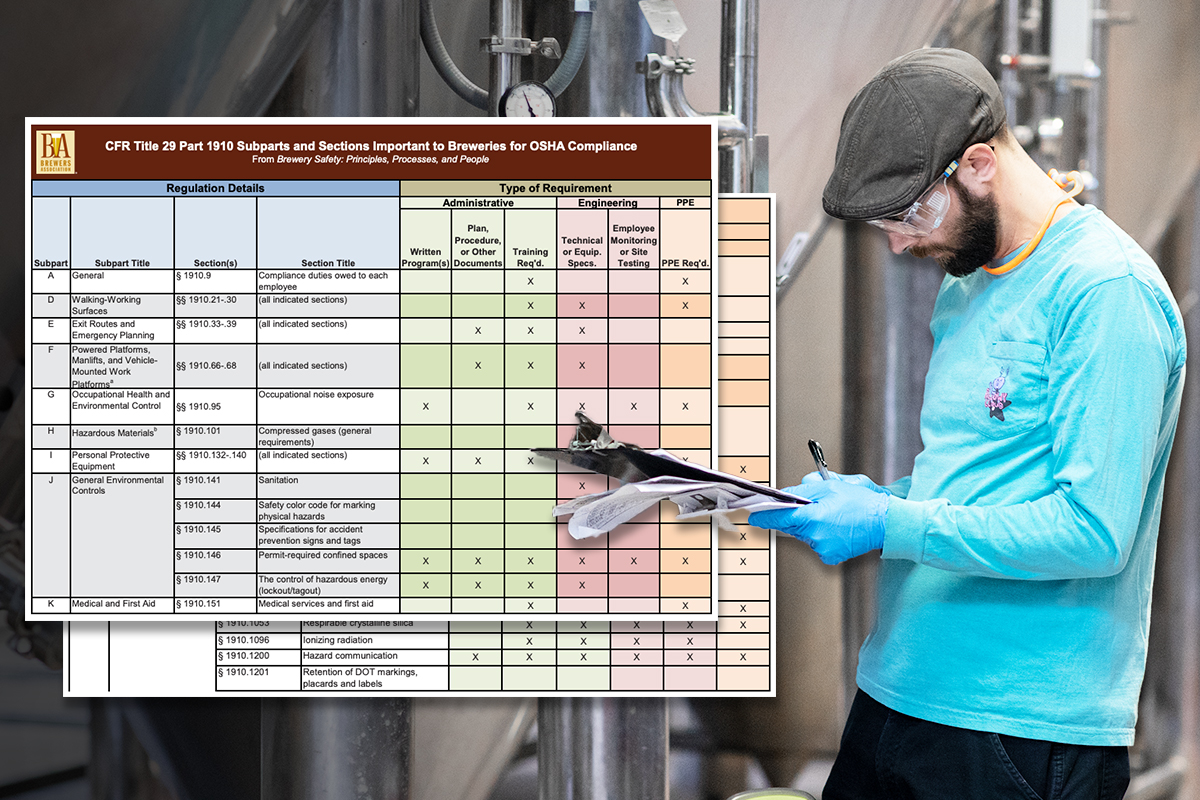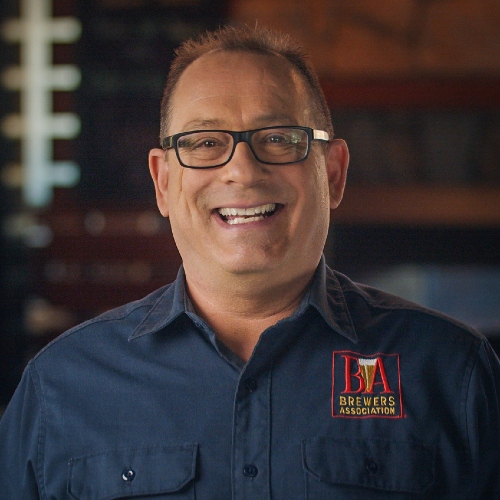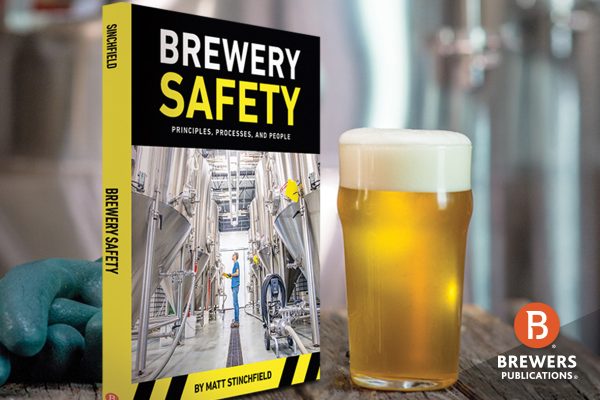The Occupational Safety and Health Administration’s (OSHA) regulatory compliance landscape can feel vast, and brewers may often feel like they lack a map to navigate it with ease. Matt Stinchfield, author of Brewery Safety: Principles, Processes, and People, has created a detailed table that summarizes the key areas and activities breweries must address to achieve compliance. Think of the table in this resource as that roadmap. It is a brewery’s go-to list for how to address regulatory compliance and create a safe working environment.
However, keep in mind that although the following table lists the minimum legal requirements for brewery workplace safety, it is not necessarily a comprehensive list for every brewery. It shows what kind of written documentation is needed, whether personal protective equipment (PPE) is required, if technical or equipment specifications need to be followed, whether training is mandatory, and lastly, if monitoring or testing needs to happen.
This list offers brewers and brewery owners a simplified overview to get the lay of the land. From there, a brewery may dive into the specifics of each requirement by using the eCFR searchable database.
Breaking It Down
There are two main parts of the Code of Federal Regulations (CFR) Title 29 that interest breweries. The table below will only dive into Part 1910.
- Part 1910 addresses workplace safety in general industry, which is any industry that’s not construction related.
- Part 1926 addresses safety and health regulations specific to construction, so look at this part if building or modifying a brewery.
The table below contains all subparts of Part 1910 that could apply to a brewery, so they may not all apply. For example, 29 CFR §1910.1096 “Ionizing radiation” would only apply to a brewery with an X-ray can fill inspection device.
How To Read the Table
The regulations listed in the table are found in Part 1910 of CFR Title 29. The CFR uses an indexing system that correlates to the table’s left-hand column titles (under Regulation Details)— Subpart, Subpart Title, Section(s), and Section Title. The right-hand columns (under Type of Requirement) refer to the specific types of requirements needed for that regulation and are organized by Administrative, Engineering, and Personal Protective Equipment (PPE) requirements. An X in the table indicates a specific requirement is needed for that regulation.
For example, in Subpart D Walking-Working Surfaces (Sections 1910.21-.30), Training, Technical or Equipment Specifications, and PPE are required. Specifications for all those requirements are found by diving into that section on the CFR website.
Types of Regulation Requirements
Written Program vs. Plan, Procedure, or Other Documents
Some regulations require either a written program or plan, require neither, or require both. Refer to the table to see if this administrative control is required, and then look to the code for guidance on implementation.
- A written program is an overarching document that describes how the employer will administer a safe workplace regarding a specific class of hazards. Templates may be used for written programs, but they often list names of responsible individuals and other unique information requiring regular updating. For example, a written program is required for respiratory protection and must contain details on medical screening, training, and PPE.
- A plan, procedure, or other document is usually a more specific document than a written program and focused on a single activity. A few examples of this requirement are emergency action plans, fire prevention plans, confined space permits, and energy control procedures.
Training Requirements
Training is typically specific to the hazards anticipated in each workplace and includes record-keeping requirements. Training can vary in frequency depending on the standard (e.g., annually or if an incident occurs). Investigate the code details of each section of the table that requires training to understand what is expected.
For example, Hazard Communication (HazCom) training can change between tasks based on the likelihood of dealing with chemicals, but forklift training has more specified content that must be followed more strictly. The Training Requirements in OSHA Standards document on OSHA’s Training Library Materials page lists all Part 1910 training requirements in one place.
Technical or Equipment Specifications
When complying with these regulations, there is generally less employer flexibility. Some regulations are very exact and specific, like those concerning railing dimensions and commercial electrical codes.
Employee Monitoring or Site Testing
These require the employer to measure certain hazards in the workplace, such as noise levels and airborne hazardous chemicals, or test employees for signs of exposure if the hazard assessment determines an injury or illness is probable (e.g., hearing functions and pulmonary testing).
Personal Protective Equipment
This includes a wide range of protective clothing and bodily appliances worn to reduce the risk of injury or illness. Most often, the employer determines what type of PPE is required for a task, but there are some stricter regulations regarding arc flash protection, hard hats in certain environments, and fall protection assemblies.
A Word on Prescriptive vs. Performance-Oriented Regulations
While reading through the types of regulations above, you may have noticed some requirements are stricter than others. In OSHA, this difference is described as prescriptive (stricter) versus performance-oriented (employer has flexibility in deciding how to control hazards). It is important to be aware of this distinction, so that a brewery’s safety program is implemented with absolute precision in the appropriate areas.
- Prescriptive regulations generally provide clear, concise, and detailed instructions on who, what, and how, with little wiggle room. They can be recognized alongside words like “shall,” “will,” and “must.” In general, these are Technical or Equipment Specs and Employee Monitoring or Site Testing requirements.
- Performance-oriented regulations require the employer to identify hazards themselves and implement appropriate planning, training, and controls suitable to their workplace. These are more flexible, but they can lead to many questions because they do not always say exactly what to do or how to do it. They are recognizable alongside suggestive words like “should,” “could,” and “may.” In general, these are Written Programs; Required Plans, Procedures, or Other Documentation; and PPE requirements.
Summary
Regardless of the type of requirement, the employer should always conduct a hazard assessment (HA) first, which will identify present and potential hazards and inform the employer of which regulations are applicable. Compliance with OSHA reduces worker compensation costs, avoids inspections, and eliminates expensive fines; it also makes your workplace safer, healthier, happier, and more productive.
A huge thanks goes out to Matt Stinchfield, whose book Brewery Safety: Principles, Processes, and People was used for the writing of this article, especially “Chapter 2: Understanding OSHA” (pp. 12-15). His book is available for purchase at Brewers Publications and other retailers.








